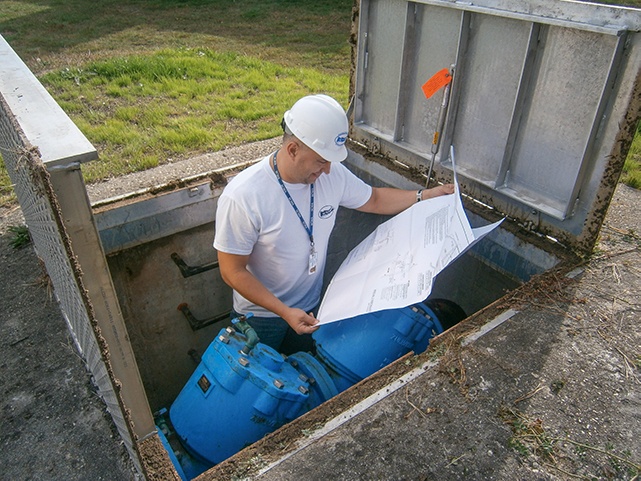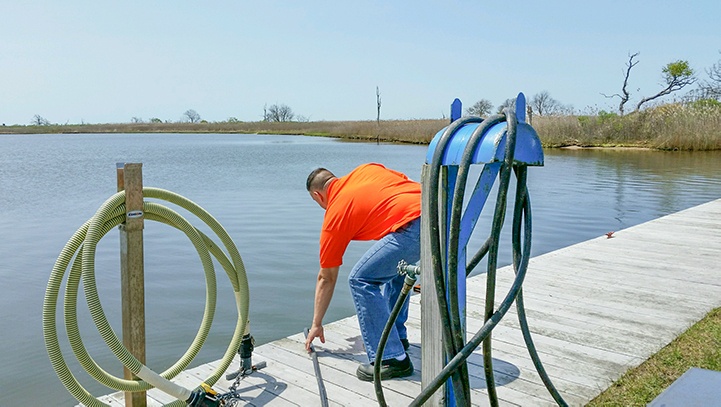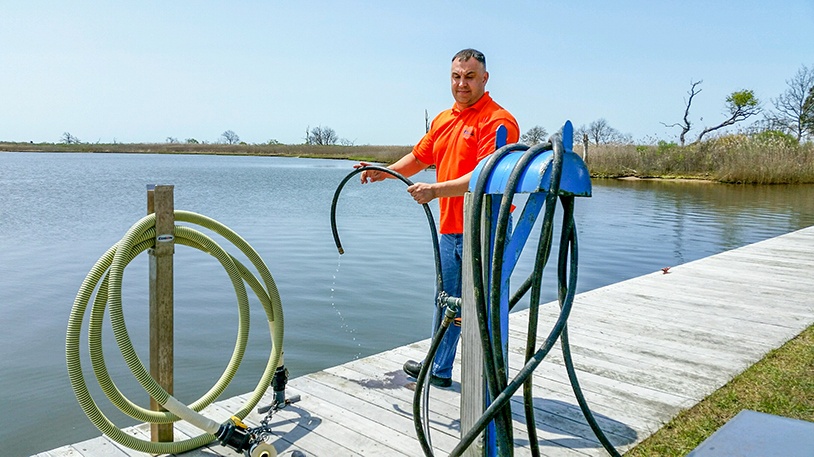What does a cross connection manager do?
They educate the public about the need for backflow preventers
 |
| A cross connection inspector checks out an RPZ backflow preventer in an above-grade bermed vault. He is confirming that the installation follows approved plans. (Photo by Suffolk County Water Authority) |
Individuals in this position provide a key link in the building permit process. They spend a lot of time reviewing mostly non-residential applications – sometimes 40 – 80 a week. They interact with other officials, contractors and the public. They manage inspectors and other staff, visit challenging project sites and perform many other duties related to managing a cross connection control program.
And, they often respond to the question, “Why do I need a backflow preventer?"
Two cross connection managers offered insights about their jobs and the challenges they face as they work to protect water quality, while still serving the public.
The American Backflow Prevention Association describes backflow as the undesirable reversal of flow of non-potable water or other substances through a cross connection and into the piping of the public drinking water system. A loss of pressure in the system can cause backflow.
Cross connections link a potable (drinking) water system and a non-potable water system. Backflow prevention assemblies or devices prevent contamination of supply lines from cross connections.
The degree of hazard determines the level of protection that is needed. (Check with your municipality for specific requirements.)
Protect Water Supply
 |
| Laura Wynhurst |
To avoid problems, integrate backflow preventer specifications into your building plans.
Cross Connection Control Manager Laura Wynhurst often explains to building permit applicants why backflow preventers are necessary to protect water quality. Then they understand the importance of these valves and why they must include them in their buildings. She works for the Suffolk County Water Authority, Oakdale, New York.
To illustrate her point, Wynhurst uses the example of washing a car. A car owner puts a garden hose into a soapy bucket of water. If water pressure drops and there’s a pressure reversal, the community would end up drinking soapy water from the car owner’s bucket. Backflow preventers stop this contamination.
“My biggest headache is when people put the cart before the horse and install the backflow preventers before the plan is approved,” said Wynhurst.
For example, applicants may build a room without making sure that the equipment and backflow preventers adhere to necessary regulations. She tries to work with building owners to avoid room reconstruction, but it may be necessary.
During planning, building plan applicants should research the needed standards of cross connection control/backflow prevention. Standards typically are based upon the degree of hazard. Is it high or low?
Other decisions include containment or isolation of the backflow preventers. For more information, see “Containment VS Isolation: The Backflow Preventer Installation Battle.”
Wynhurst brings varied experience to her role as the Suffolk County Water Authority manager. She began as a clerk in Customer Service where she gained experience with a variety of duties. Then she transferred to the Cross Connection Department as a clerk. Promotions to assistant supervisor and manager followed.
Cross Connection Regulations
 |
| Nissa Pauley |
Cross Connection Control Supervisor Nissa Pauley and her staff from Durham, North Carolina, review 40 to 80 building permit applications weekly for non-residential meters. For the past six-eight years, all installations have been above ground.
If an underground backflow preventer fails, owners are responsible for bringing the backflow preventers up to code, ultimately relocating the installation above ground.
The City of Durham pays a lot of attention to its cross connections. In addition to running a containment program, the city also requires backflow protection for internal potable drinking water for containment on items such as make-up lines to boilers, chillers, etc.
Coordinating Regulations
Pauley serves as vice president of the State of North Carolina AWWA Backflow Sub-Committee. One of the group’s goals is to make sure the North Carolina Plumbing Code jives with the North Carolina Department of Environmental and Natural Resources, Title 15A.
In 2006, Pauley began as a cross connection control inspector for the City of Durham and then became a Level 3 plumbing inspector. She now serves as the control supervisor.
In her previous role, she prepared backflow assembly schematics using AutoCAD to assist installers and customers. Pauley helped provide safe drinking water to customers by eliminating potentially hazardous containments from prohibited cross connections. She achieved that goal by conducting inspections and field surveys and reviewing site plans.
 |
| An inspector discovers an inappropriate cross connection - a hose dropped in the bay at a marina. |
 |
|
The inspector removes the hose. A vacuum breaker was installed to the hose bib, but that is not considered an approved backflow preventer in the State of New York because it can’t be tested. (Photos by Suffolk County Water Authority) |
For years, Pauley has increased public awareness about the potential hazards of cross connections and ways to eliminate them. She’s worked with homeowner associations, contractors, architects, engineers and citizens.
She collaborates with other city departments, inspectors and contractors to achieve cross connection goals of proper installation, annual testing and maintenance of backflow preventers.
Engineers Need to Collaborate
Who is going to specify backflow preventers – a licensed civil engineer or mechanical or plumbing engineer? Civil engineers typically design containment backflow systems. Clients often turn to mechanical and plumbing engineers to design isolation systems.
Wynhurst reports problems arise when the Water Authority approves plans for one kind of backflow system, but not the other one.
“I wish they would all get together and collaborate and then submit the design installation,” she said.
Over the years, Wynhurst has developed a close working relationship with many engineers and plumbers. She’s always willing to provide information regarding the state’s sanitary code requirements.
Pauley agrees that design engineers may not properly specify the correct backflow preventers. She contends that they should know the difference between various backflow assemblies.
Work Together on Plans
Both cross connection managers encourage engineers to collaborate during the plan review process.
The City of Durham hosts quarterly meetings with the trade personnel, engineering and architects to discuss upcoming changes and requirements.
RPZs Used for High Hazard Facilities
When there’s a high hazard, plans must include RPZs, the managers explained. Both follow state code regulations.
Suffolk County’s Cross Connection office reviews installation of backflow preventers and site plans. All new buildings must install Reduced Pressure Zone Valve Assemblies (RPZ) backflow preventers.
Pauley said RPZs are more common in Durham because it has many high hazard facilities including biopharmaceutical plants, greenhouses and medical structures.
Use of Double Checks
Double check valves are allowed in facilities where the potential hazard is low. In Suffolk County, for example, double checks are allowed on fire line services if there isn’t an alternate supply of water within 1,700 feet of the fire department connection. In addition, anti-freeze, glycol or chemicals cannot be within the system.
Owners may install double check valves below grade when providing irrigation or seasonal services.
In the City of Durham, double checks also may be used on low hazard applications, if they follow the North Carolina Plumbing Code. The valves typically are appropriate for office buildings with four stories or less.
Pauley said some municipalities install double checks in vaults. She explained that the ability to get a “drain to sunlight” from the vault may be difficult. In that case, installing the backflow preventer above ground is easier.
For communities near sea level, ground water also may be an issue. If the double check is below ground, it could become submerged, deteriorating the assembly.
Pauley emphasized another benefit. With above-ground installations, there’s no need for confined space training.
For more information, check out “DC VS RPZ – What’s the Difference and Why Should You Care?”
|
Communities Take Closer Look at Backflow Preventers Safe-T-Cover’s research indicates a growing trend towards more stringent regulations for backflow preventer valve specifications and locations. A few of the emerging trends in the use of backflow preventer assemblies are as follows:
|
Yearly Review
Cross connection managers also face another challenging task: tracking the yearly testing of backflow preventer assemblies.
Suffolk County implemented an online test portal system that is more accurate than the former approach. It saves time and cuts down on use of paper and storage.
Wynhurst believes this is the first such system in the state. Previously, testers had to fill out hand-written forms that filled up lots of file cabinets.
“My biggest problems are resources and compliance,” Pauley said. Her department also manages annual testing of backflow preventers.
About 60 percent of the customers who have backflow preventers respond to requests for test results during the mailed 1st notice. For customers who don’t submit test results, a notice of violation is sent out. The city can lock violators’ meters as a last resort.
Serve the Public
Like other cross connection managers, Wynhurst and Pauley both work to provide great customer services, while still protecting the public water supply.
Throughout the country, states and communities decide how to manage cross connections. There’s no “one size fits all” for regulations. Pauley emphasizes that permit holders should research regulations that will impact their project and its hazard level.
“It’s not our goal to turn off water; we want our customers to have the ability to use our water,” Pauley said. “We want to keep it safe for drinking.”
Cross connection managers like Wynhurst and Pauley are ready to help business owners prepare building plans to meet local regulations. As a result, the public enjoys a quality water supply. The proper installation of backflow preventers also reduces the potential for flood damage.
The mission of protecting water unites communities. Cross connection managers play a key role in this effort as they encourage stakeholders to collaborate and implement the best solutions.
Leslie Blaize, Certified Professional Services Marketer and owner of Blaize Communications, specializes in writing about the Architecture/Engineering/Construction industry. See www.blaizecommunications.com.




